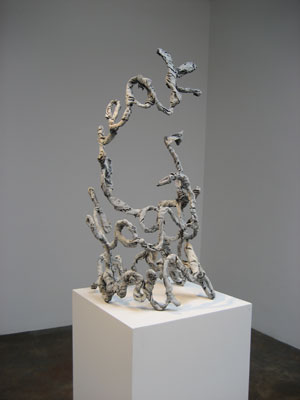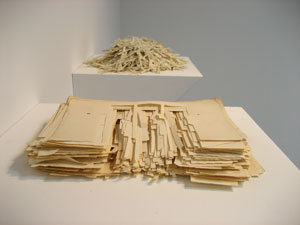Two exhibitions by well-known Texas-based artists, Annette Lawrence and Joseph Havel, are on view at Dunn and Brown Contemporary in Dallas. While the works of both artists are presented in succinct separate shows—Lawrence in the project gallery, Havel in the main gallery—many parallels can be drawn between the two as the artists each explore quotidian materials and found texts in their work.
Annette Lawrence’s Free Paper creates a somewhat mysterious prelude to the main installation; three graphite drawings consisting of small horizontal lines create indiscernible, ziggurat-like forms. The source of these drawings is initially unclear but later revealed in the project gallery, where thirteen shelves hold irregular stacks of thinly-torn paper. The differing sizes and shapes of the stacks clearly echo the forms seen in the drawings, which are actually rubbings documenting these torn-paper towers. While formally appealing, what is most interesting is that the stacks consist of accumulations of junk mail. According to the press release, each stack, such as Free Paper 11/05 (2006 – 2008), is a monthly compilation of circulars received by Lawrence at her home. The amount of torn mailing advertisements in the gallery attests to the sheer abundance of advertising we encounter in merely one aspect of our daily lives. For the most part, the actual advertisements are difficult to decipher as they are each hand-torn into two-inch strips; only bits of text on the fringed edges are legible. Lawrence disengages these advertisements from their original function—what they are selling is null and void here—and reinvents them as personal chronicles of the months and years passing by.
This use of everyday, mundane materials as art objects is certainly not a new practice; however, many elements are at work in Free Paper. Like On Kawara’s Today Series—paintings inscribed solely with the date the work was created and supplemented by newspaper articles highlighting the events of that day—Lawrence transforms the mailed advertisements into a journal of sorts, recording both the passage of time and the repetitive nature of our daily lives. Also at play here, and akin to much conceptual art, is the presumption that each stack is guided by chance—in this case, which companies acquire your name and address and what the mailman may in turn bring. Perhaps in a subtle gesture to the torn posters of Jacques Villeglé, Lawrence also deconstructs the original, persuasive messages in advertisements and transforms them into something illegible and anew.
Paper Surface Circle (2008) and Paper Surface Circle #2 (2008) are two circles made entirely from brown paper bags hung on the gallery walls. Paper Surface Circle #2 is smaller at 58 inches in diameter, and is installed in the gallery’s entryway. Paper Surface Circle faces the stacks of torn paper in the larger gallery, and at ten feet in diameter, it acts as a looming, growing presence in this context. The folds of the sacks’ bottoms collectively form geometric patterns within the circle. As their edges curl, the paper circles seem to effortlessly float on the gallery walls. Although their effect is simple and ethereal, the source of the circles’ material is obvious.
Indeed, paper bags are containers for consumer goods, and junk mail advertises the products we may carry out in such sacks; paired together they create a cyclical meditation on commodities. The goods themselves are missing, but Lawrence (rightly) makes it difficult not to see the art object’s inextricable link to commodity.
Joseph Havel does his own transformation of everyday materials and text in And never at any time have you resembled snow. Havel’s show centers on and gently unravels John Berryman’s 1969 book of poems, The Dream Songs. Hundreds of poems constitute The Dream Songs. They are often narrative, dense and based on autobiographical allusions; the 366th poem states: "These Songs are not meant to be understood, you understand. / They are only meant to terrify & comfort." Berryman’s dichotomous description of his poems is ardently carried out in Havel’s show. While not terrifying per se, there are levels of comfort and discomfort in meeting Havel’s works. Moreover, most of the works here are discomforting as the sourced poems are rendered indiscernible. The cursive, bronzed snippets of lines are furled into balls. Like Lawrence’s stacks of adverts, Havel strips away and reworks the original meaning of the sourced texts, in turn creating amended narratives.
The comforting aspect of this body of work is that Havel uses materials that are quotidian and easily recognizable (like Lawrence’s), such as shirt labels, fabric, wire and book pages. The majority of the works in the exhibition are jam-packed Plexiglas vitrines holding countless shirt labels, each embellished with one word taken from Berryman’s poems—most often it is “Nothing,” as in Nothing I (snow) (2008). In this series, the labels are organized mechanically in straight lines, diagonals, or squares, and often it is only one label peeking out where its message is decipherable. Oftentimes the labels tend to jumble in the center of the pieces, adding a human touch to an otherwise organized pattern. This use of common shirt labels—like Lawrence’s junk mail—notes the passing of time with the repetitive use of an object one encounters daily.
Perhaps the most eye-catching work in Havel’s exhibition is the large wire and fabric installation, And never at any time have you resembled snow II (2008). Situated in the back of the gallery in front of an empty wall, the work is suspended freely in the air and features sewing needles dangling from threads. Bound wire creates a tangle of illegible text, while the title’s named verse draws outward with curves and loops; the viewer must circle the piece to read the cursive words. As the dramatic anchor of the exhibition, however, it could have been better lit. It would have been nice to see the text’s shadow on the wall, adding a dimension seen in other similar Havel pieces.
Two Dream Songs (Studio Version) (2008) is a must-see piece. It consists of two shelves; one holds pages torn out from Berryman’s book with all text cut out, leaving pages that are physically and conceptually deflated, while the other embraces the cut-out lines, forming a mound of now defunct poetry. Like Marcel Broodthaers’ Un Coup de dés jamais n’abolira le hasard—a 1969 book in which Broodthaers took Stephan Mallarmé’s poem of the same title and blacked-out all of the text—Havel strips away the meaning from the original poetry. As Broodthaers transformed Mallarmé’s text into a visual image consisting of strategic black bars, Havel similarly turns Berryman’s poetry into a sculptural mound of indecipherable language, perhaps also creating an additional narrative.
While the works of Lawrence and Havel certainly hold their own, their common threads make them an apt pairing as they manipulate poetry and the commonplace into things both personal and elusive. Even though the two bodies of work are separated, their dialogue on the passage of time through the use of ethereal, everyday materials moves fluidly between the galleries.
Annette Lawrence:Free Paper
Joseph Havel: And never at any time have you resembled snow
October 24 – December 13, 2008
Dunn and Brown Contemporary
Alison Hearst is an art historian and writer living in Fort Worth.
Also by Alison Hearst –
"Uncommon Sense" at Fort Worth Contemporary Arts










2 comments
dude, you can come up with a better The Beast.
true, but I don’t know if I can come up with a nerdier one!